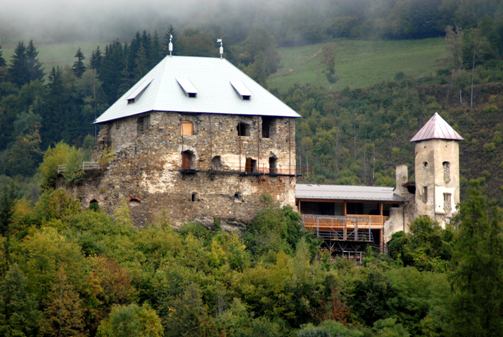

Location: Carinthia Map
Constructed: 1070- 1103
Burgruine Haimburg, also known as Burg Haimburg or Heunburg, is a medieval rock castle ruin located in the village of Haimburg near Völkermarkt in the Austrian state of Carinthia (Kärnten). Perched on an isolated slate rock formation in the Jauntal plain where the Diexer Bach flows into the valley, the castle overlooks a historically significant area with evidence of Neolithic, Celtic, Roman, Germanic, and Slavic settlements. Constructed as a defensive stronghold against invasions such as those by the Avars, it represents one of Carinthia's oldest and most culturally layered sites. Today, the ruin blends historical preservation with modern cultural use, particularly as a venue for summer theater performances, attracting visitors interested in medieval history, architecture, and performing arts amid the scenic alpine surroundings.
The history of Burgruine Haimburg dates back to the late 11th
century, rooted in Carinthia's feudal landscape and the need for
fortifications in a region marked by cultural intermingling and external
threats. The castle was likely built between 1070 and 1103 by the Counts
of Heunburg, a noble family originating from Saxony and documented in
Carinthia since 1070. It served as their primary seat, replacing the
older Rauterburg (a Carolingian-era fortress from the 9th-10th centuries
located northwest of Haimburg). The first written mention of the castle
appears in 1103 as "Huneburch," highlighting its role in protecting
local populations from invaders like the Avars.
The Counts of
Heunburg rose to prominence in the 12th and 13th centuries, becoming one
of Carinthia's most powerful families. However, their influence waned
after Ulrich III von Heunburg's defeat by the Habsburgs in the 1293
Battle of Wallersberg. By 1228, the family had shifted their residence
to Bleiberg, and the male line extinguished in 1322 with the death of
Count Hermann. Ownership passed through inheritance to the Counts of
Pfannberg until 1362, when Johann, the last Pfannberger, died. The
castle then transferred to the Counts of Gorizia (Görz) as a ducal fief.
In 1460, following the Peace of Pusarnitz, it came under Habsburg
control, marking its integration into the broader Austrian imperial
domain.
Later heirs included the Lords of Sanneck and the Counts of
Cilli (Celje), whose coat of arms—three golden stars on a blue
background—later influenced Slovenia's national emblem. The castle
gradually fell into disrepair over the centuries, but in 1990, the
privately owned site saw the formation of the association "Rettet die
Heunburg" to initiate repairs and preservation efforts. From 1995 to
2009, it hosted theater productions by Theater k.l.a.s., and since 2011,
the Heunburg Theater has staged summer performances, revitalizing the
ruin as a cultural hub.
As a classic rock castle (Felsenburg), Burgruine Haimburg is built
directly onto a prominent, isolated slate outcrop, leveraging the
natural terrain for defense. This strategic positioning on a hill
provides commanding views over the Jauntal plain and the Diexer Bach
valley, emphasizing its original role as a fortified residence. The
surviving elements reflect medieval architecture from the 11th-13th
centuries, with later modifications.
Key features include the
preserved gate tower (Torturm) and portions of the palas (main
residential hall), which remain in their original condition. To the west
lies the former chapel dedicated to St. Alexius, adding a religious
dimension to the layout. The overall structure is compact, typical of
early medieval hilltop fortifications in Carinthia, with stone walls
integrated into the rock base. The ruins today exhibit a mix of intact
and decayed elements, with overgrown areas contributing to a romantic,
atmospheric ambiance. Nearby historical sites, such as the Kirche
Haimburg church and Burgruine Rauterburg, complement the castle's
setting, highlighting the region's dense medieval heritage.
Burgruine Haimburg is maintained as a preserved ruin, privately owned and under ongoing restoration by the "Rettet die Heunburg" association since 1990. These efforts have stabilized the structure, preventing further decay while respecting its historical integrity. The site no longer serves defensive or residential purposes but has been repurposed as a cultural venue, primarily hosting open-air theater performances during the summer months by the Heunburg Theater since 2011. These events, which include plays and cultural productions, draw audiences to the atmospheric ruins, blending history with contemporary arts. The castle is protected as a cultural monument, contributing to Carinthia's rich array of medieval sites.
Burgruine Haimburg is a lesser-visited attraction with limited
reviews, holding a 4.0 out of 5 rating on Tripadvisor based on a small
number of contributions (around 1 detailed review). Visitors appreciate
its cultural highlights, including theater performances that bring the
medieval setting to life, though some note the site's remote location
and lack of extensive facilities. The ruins are freely accessible
year-round with no formal opening hours or admission fees for general
exploration, making it ideal for self-guided visits.
Access
involves a short, 5-minute uphill walk from parking in Haimburg village
(coordinates approximately N 46°41.495 E 14°40.090). Sturdy footwear is
recommended due to uneven terrain and steps, and the site may not be
fully accessible for those with mobility issues. For theater events,
tickets are available through platforms like Trip.com or the Heunburg
Theater's channels, with performances typically in July and August—check
current schedules for details, as prices vary by event. Combine a visit
with nearby attractions like Burgruine Rauterburg, Stift Griffen abbey,
or the town of Völkermarkt for a broader exploration of Carinthia's
history. Photography is permitted, and the panoramic views over the
Jauntal are a highlight, especially at sunset.